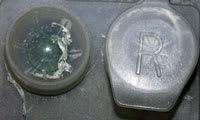contact lens
care
Maintaining
and Disinfecting GP Diagnostic Lenses
BY
MICHAEL A. WARD, MMSC, FAAO
Gas permeable diagnostic contact lens sets will last for years if you care for and store them properly. Some trial sets get regular use, while some are used only rarely. Regardless of the frequency of use, you must be concerned about how you store and care for these lens sets to ensure cleanliness, parameter accuracy and safety. Figure 1 shows an example of an improperly stored GP diagnostic lens.
Regularly Check Parameters
Unlike soft lenses, you can accurately verify GP lens parameters with standard office instrumentation. You can use a magnifying loupe to inspect lens surfaces and to verify optic zone and overall diameters. A lensometer can help you check the lens power (for high powers, front vs. back vertex becomes important) and optical quality. A radiuscope can accurately measure the base curves and allow you to detect any warpage. However, one thing these instruments can't tell us is whether the lens surfaces are free from microbial contamination.
Periodically inspect all GP diagnostic lenses to ensure that each is in its correctly labeled container and that the parameters haven't altered over time. Replace any warped or out of spec lenses.
Diagnostic Lens Care
Store GP diagnostic lenses wet, in conditioning/storage solution or dry. Each method offers potential advantages. Lenses stored wet are theoretically better conditioned for immediate use, whereas lenses stored dry require less maintenance.
Other considerations exist as well. No contact lens disinfecting solution is approved for lens storage for greater than 30 days. You must redisinfect lenses that you store wet in chemical storage/disinfecting/conditioning solutions at least every 30 days. If you don't regularly maintain wet-stored GP lenses, evaporation and aging may alter the chemical composition of the storage solution, which may compromise its antimicrobial efficacy.
You must clean and disinfect all diagnostic contact lenses prior to their reuse. The Centers for Disease Control and Prevention (CDC) recommends using ophthalmic grade 3% hydrogen peroxide for disinfection of rigid lenses. Specifically, "Contact lenses used in trial fittings should be disinfected after each fitting by using a hydrogen peroxide contact lens disinfecting system for 10 minutes." http://wonder.cdc.gov/wonder/prevguid/p0000318/p0000318.asp). The two primary peroxide systems available in the United States are Clear Care (CIBA Vision) and UltraCare (Advanced Medical Optics).
|
|
|
Figure 1. Improperly stored GP diagnostic contact lens. |
Recommendation
Clean GP diagnostic lenses with an approved surfactant cleaner such as Boston Advance Cleaner (Bausch & Lomb), Optimum Extra Strength Cleaner (Lobob Laboratories) or MiraFlow Extra Strength Daily Cleaner (CIBA) after each use.
Disinfect the lenses with an approved peroxide system (Clear Care or UltraCare) for a minimum of 10 minutes.
Store rigid diagnostic lenses dry for long-term storage.
Prior to reuse, clean the lenses with an approved cleaner, then rinse and wet them with an appropriate wetting or conditioning solution. I've followed this practice for many years and I do not encounter surface wetting problems following dry storage of GP lenses.
Mr. Ward is an instructor in ophthalmology at Emory University School of Medicine and Director, Emory Contact Lens Service.




